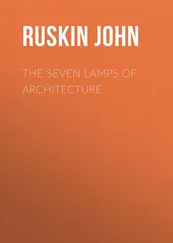John Ruskin - The Poetry of Architecture
Здесь есть возможность читать онлайн «John Ruskin - The Poetry of Architecture» — ознакомительный отрывок электронной книги совершенно бесплатно, а после прочтения отрывка купить полную версию. В некоторых случаях можно слушать аудио, скачать через торрент в формате fb2 и присутствует краткое содержание. Жанр: foreign_antique, foreign_home, literature_19, visual_arts, на английском языке. Описание произведения, (предисловие) а так же отзывы посетителей доступны на портале библиотеки ЛибКат.
- Название:The Poetry of Architecture
- Автор:
- Жанр:
- Год:неизвестен
- ISBN:нет данных
- Рейтинг книги:5 / 5. Голосов: 1
-
Избранное:Добавить в избранное
- Отзывы:
-
Ваша оценка:
- 100
- 1
- 2
- 3
- 4
- 5
The Poetry of Architecture: краткое содержание, описание и аннотация
Предлагаем к чтению аннотацию, описание, краткое содержание или предисловие (зависит от того, что написал сам автор книги «The Poetry of Architecture»). Если вы не нашли необходимую информацию о книге — напишите в комментариях, мы постараемся отыскать её.
The Poetry of Architecture — читать онлайн ознакомительный отрывок
Ниже представлен текст книги, разбитый по страницам. Система сохранения места последней прочитанной страницы, позволяет с удобством читать онлайн бесплатно книгу «The Poetry of Architecture», без необходимости каждый раз заново искать на чём Вы остановились. Поставьте закладку, и сможете в любой момент перейти на страницу, на которой закончили чтение.
Интервал:
Закладка:
46. Of the adaptation of the building to climate and character, little can be said. When I called it "national," I meant only that it was quite sui generis , and, therefore, being only found in Switzerland, might be considered as a national building; though it has none of the mysterious connection with the mind of its inhabitants which is evident in all really fine edifices. But there is a reason for this; Switzerland has no climate, properly speaking, but an assemblage of every climate, from Italy to the Pole; the vine wild in its valleys, the ice eternal on its crags. The Swiss themselves are what we might have expected in persons dwelling in such a climate; they have no character. The sluggish nature of the air of the valleys has a malignant operation on the mind; and even the mountaineers, though generally shrewd and intellectual, have no perceptible nationality: they have no language, except a mixture of Italian and bad German; they have no peculiar turn of mind; they might be taken as easily for Germans as for Swiss. No correspondence, consequently, can exist between national architecture and national character, where the latter is not distinguishable. Generally speaking, then, the Swiss cottage cannot be said to be built in good taste; but it is occasionally picturesque, frequently pleasing, and, under a favorable concurrence of circumstances, beautiful. It is not, however, a thing to be imitated; it is always, when out of its own country, incongruous; it never harmonizes with anything around it, and can therefore be employed only in mimicry of what does not exist, not in improvement of what does. I mean, that any one who has on his estate a dingle shaded with larches or pines, with a rapid stream, may manufacture a bit of Switzerland as a toy; but such imitations are always contemptible, and he cannot use the Swiss cottage in any other way. A modified form of it, however, as will be hereafter shown, may be employed with advantage. I hope, in my next paper, to derive more satisfaction from the contemplation of the mountain cottage of Westmoreland, than I have been able to obtain from that of the Swiss.
IV.
THE MOUNTAIN COTTAGE—WESTMORELAND
47. When I devoted so much time to the consideration of the peculiarities of the Swiss cottage, I did not previously endeavor to ascertain what the mind, influenced by the feelings excited by the nature of its situation, would be induced to expect, or disposed to admire. I thus deviated from the general rule which I hope to be able to follow out; but I did so only because the subject for consideration was incapable of fulfilling the expectation when excited, or corresponding with the conception when formed. But now, in order to appreciate the beauty of the Westmoreland cottage, it will be necessary to fix upon a standard of excellence, with which it may be compared.
One of the principal charms of mountain scenery is its solitude. Now, just as silence is never perfect or deep without motion, solitude is never perfect without some vestige of life. Even desolation is not felt to be utter, unless in some slight degree interrupted: unless the cricket is chirping on the lonely hearth, or the vulture soaring over the field of corpses, or the one mourner lamenting over the red ruins of the devastated village, that devastation is not felt to be complete. The anathema of the prophet does not wholly leave the curse of loneliness upon the mighty city, until he tells us that "the satyr shall dance there." And, if desolation, which is the destruction of life, cannot leave its impression perfect without some interruption, much less can solitude, which is only the absence of life, be felt without some contrast. Accordingly, it is, perhaps, never so perfect as when a populous and highly cultivated plain, immediately beneath, is visible through the rugged ravines, or over the cloudy summits of some tall, vast, and voiceless mountain.
48. When such a prospect is not attainable, one of the chief uses of the mountain cottage, paradoxical as the idea may appear, is to increase this sense of solitude. Now, as it will only do so when it is seen at a considerable distance, it is necessary that it should be visible, or, at least, that its presence should be indicated, over a considerable portion of surrounding space. It must not, therefore, be too much shaded by trees, or it will be useless; but if, on the contrary, it be too conspicuous on the open hillside, it will be liable to most of the objections which were advanced against the Swiss cottage, and to another, which was not then noticed. Anything which, to the eye, is split into parts, appears less as a whole than what is undivided. Now, a considerable mass, of whatever tone or color it may consist, is as easily divisible by dots as by lines; that is, a conspicuous point, on any part of its surface, will divide it into two portions, each of which will be individually measured by the eye, but which will never make the impression which they would have made, had their unity not been interrupted. A conspicuous cottage on a distant mountain side has this effect in a fatal degree, and is, therefore, always intolerable.
49. It should accordingly, in order to reconcile the attainment of the good, with the avoidance of the evil, be barely visible: it should not tell as a cottage on the eye, though it should on the mind; for be it observed that, if it is only by the closest investigation that we can ascertain it to be a human habitation, it will answer the purpose of increasing the solitude quite as well as if it were evidently so; because this impression is produced by its appeal to the thoughts, not by its effect on the eye. Its color, therefore, should be as nearly as possible that of the hill on which, or the crag beneath which, it is placed; its form, one that will incorporate well with the ground, and approach that of a large stone more than of anything else. The color will consequently, if this rule be followed, be subdued and grayish, but rather warm; and the form simple, graceful, and unpretending. The building should retain the same general character on a closer examination. Everything about it should be natural, and should appear as if the influences and forces which were in operation around it had been too strong to be resisted, and had rendered all efforts of art to check their power, or conceal the evidence of their action, entirely unavailing. It cannot but be an alien child of the mountains; but it must show that it has been adopted and cherished by them. This effect is only attainable by great ease of outline and variety of color; peculiarities which, as will be presently seen, the Westmoreland cottage possesses in a supereminent degree.
50. Another feeling, with which one is impressed during a mountain ramble, is humility. I found fault with the insignificance of the Swiss cottage, because "it was not content to sink into a quiet corner, and personify humility." Now, had it not been seen to be pretending, it would not have been felt to be insignificant; for the feelings would have been gratified with its submission to, and retirement from, the majesty of the destructive influences which it rather seemed to rise up against in mockery. Such pretension is especially to be avoided in the mountain cottage: it can never lie too humbly in the pastures of the valley, nor shrink too submissively into the hollows of the hills; it should seem to be asking the storm for mercy, and the mountain for protection: and should appear to owe to its weakness, rather than to its strength, that it is neither overwhelmed by the one, nor crushed by the other.
51. Such are the chief attributes, without which a mountain cottage cannot be said to be beautiful. It may possess others, which are desirable or objectionable, according to their situation, or other accidental circumstances. The nature of these will be best understood by examining an individual building. The material is, of course, what is most easily attainable and available without much labor. The Cumberland and Westmoreland hills are, in general, composed of clay-slate and gray-wacke, with occasional masses of chert 7(like that which forms the summit of Scawfell), porphyritic greenstone, and syenite. The chert decomposes deeply, and assumes a rough brown granular surface, deeply worn and furrowed. The clay-slate or gray-wacke, as it is shattered by frost, and carried down by torrents, of course forms itself into irregular flattish masses. The splintery edges of these are in some degree worn off by the action of water; and, slight decomposition taking place on the surface of the clay-slate, furnishes an aluminous soil, which is immediately taken advantage of by innumerable lichens, which change the dark gray of the original substance into an infinite variety of pale and warm colors. These stones, thus shaped to his hand, are the most convenient building materials the peasant can obtain. 8He lays his foundation and strengthens his angles with large masses, filling up the intervals with pieces of a more moderate size; and using here and there a little cement to bind the whole together, and to keep the wind from getting through the interstices; but never enough to fill them altogether up, or to render the face of the wall smooth. At intervals of from 4 ft. to 6 ft. a horizontal line of flat and broad fragments is introduced projecting about a foot from the wall. Whether this is supposed to give strength, I know not; but as it is invariably covered by luxuriant stonecrop, it is always a delightful object.
Читать дальшеИнтервал:
Закладка:
Похожие книги на «The Poetry of Architecture»
Представляем Вашему вниманию похожие книги на «The Poetry of Architecture» списком для выбора. Мы отобрали схожую по названию и смыслу литературу в надежде предоставить читателям больше вариантов отыскать новые, интересные, ещё непрочитанные произведения.
Обсуждение, отзывы о книге «The Poetry of Architecture» и просто собственные мнения читателей. Оставьте ваши комментарии, напишите, что Вы думаете о произведении, его смысле или главных героях. Укажите что конкретно понравилось, а что нет, и почему Вы так считаете.












